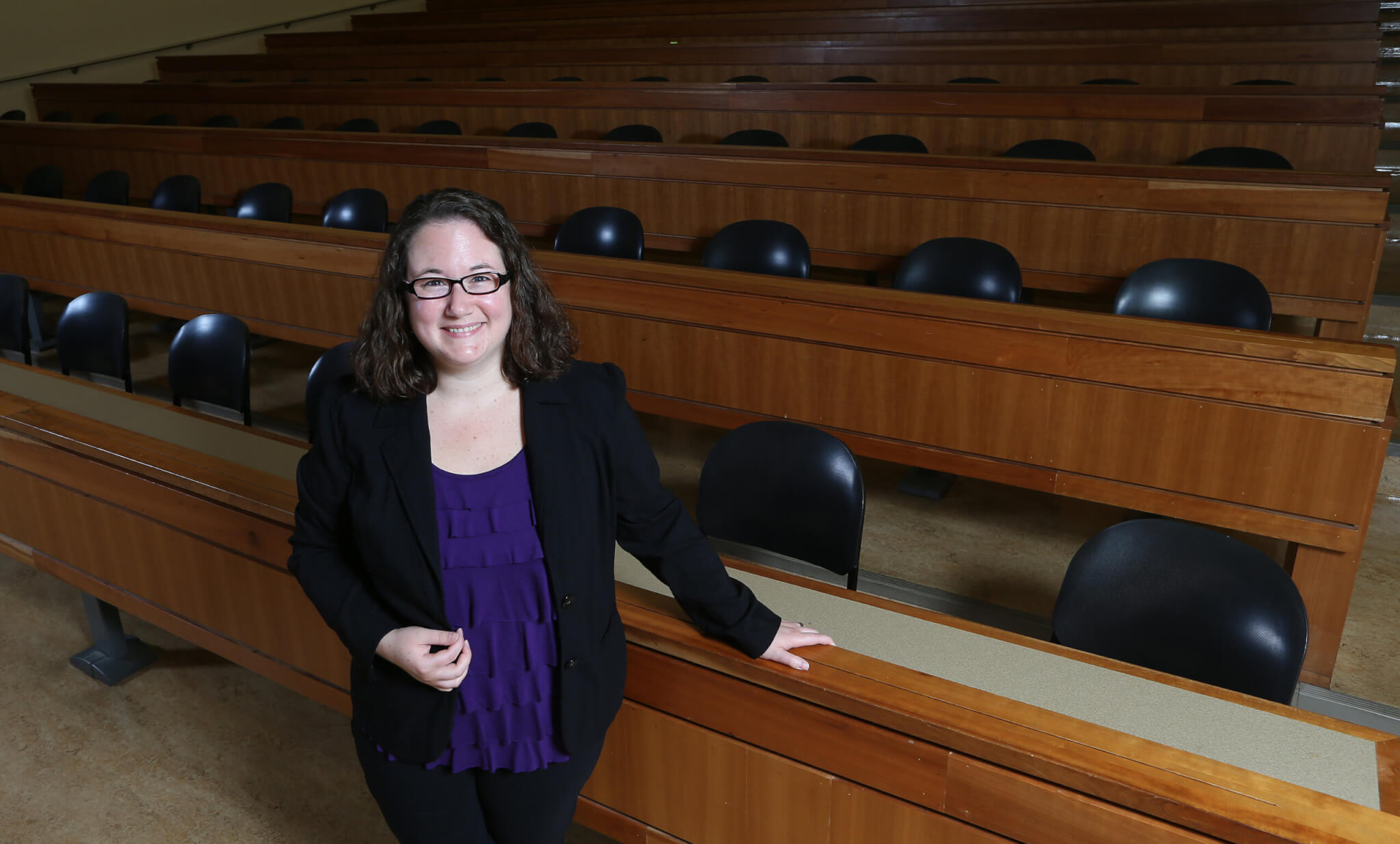As a professor of agricultural economics at a major research institution, Nicole Olynk Widmar relies on Purdue’s high-speed internet. But once she leaves campus and arrives home about 15 minutes later, Widmar counts herself lucky to even connect to the internet. Zoom can, at times, be a pipe dream.
Still, Widmar calls herself privileged in her ability to pay for home internet, delivered via DSL through her landline phone.
“You’d hardly define me as rural in the true sense,” she says. But Widmar can relate to Indiana’s rural residents who are on the wrong side of the digital divide — the gap between those who have ready access to computers and the internet, and those who do not.
Never has the divide been sharper than during the coronavirus outbreak

Widmar, along with her coauthor John Lai from the University of Florida, explores the pandemic’s impact on U.S. residents lacking sufficient internet in newly published research, “Revisiting the Digital Divide in the COVID-19 Era,” in Applied Economic Perspectives and Policy.
She further examines how this issue touches everyone, not just those in rural areas, in “Internet Have-Nots (Including Many Children) are Suffering Digital Divide Consequences in the COVID-19 Era,” online at Purdue’s Center for Food and Agribusiness Consumer Corner.
Widmar has explored the topic since 2015, when Purdue Extension and a team from the Tipmont REMC, based in Linden, Indiana, asked her to work alongside the late Wally Tyner in assessing rural internet demand. The company is also Widmar’s electricity provider.
Late-night homework uploads
Internet speeds at the home of Widmar’s neighbor, Maggie Rose, vary from 2 Mbps to 10 to zero. “Most of the time, it’s slow and glitchy,” Rose says. The pandemic made it worse, when neighbors sharing bandwidth on the DSL line lowered productivity for everyone.
Rose and her husband Matt, along with her parents, own the two nearby Nine Irish Brothers restaurants, and Matt is general manager of the West Lafayette pub. When schools were closed, the family juggled his need to do payroll with their two children’s virtual classes. Their daughter couldn’t upload assignments until after midnight.
Rose doesn’t live on a farm. “But even if you were a farm business, you would need good internet,” she says, citing a nearby agribusiness: “Can you imagine, trying to run a multimillion dollar company on a DSL line? Sometimes the GM comes into town to our pub to use our wi-fi.”
“The internet is a luxury, but it’s not really — not anymore.”

School in the car
“Societally we believe in education for all kids,” Widmar says. But research shows students without reliable internet access are disadvantaged compared to their better-connected peers.
Public school corporations can control many things related to technology, but they can’t control families’ access to the internet at home, says Devin Arms, technology director for Tippecanoe School Corporation. When TSC and other school districts across the country pivoted to remote learning with little time for preparation and planning, the corporation had already invested in devices for students, staff training and wi-fi.
“But we do have areas within our boundaries that are underserved and unserved,” Arms says. “We have been aware of this for years, and it speaks to the challenges of K-12 education.”
During the pandemic, Tipmont REMC and TSC teamed up to establish outdoor “hot spots” to make internet access available to families without it at home. The partners started with four middle school parking lots, and over the summer added installations at TSC’s other three middle schools and all 12 elementary schools.
“A device has to be charged, you have to drive to the parking lot, and there’s not an indoor bathroom,” says Widmar the parent. Adds Widmar the economist, “Who is paying for that? When did this public good become the school's responsibility, and are we taking that into account when funding or supporting them?”
Arms agrees the stopgap measures, while useful in the short-term, created challenges for working families. But he points to the larger impact of the digital divide on education.
“When you think about the educational content and types of learning tasks that our teachers want students to do today — video, tutorials, online textbooks — and a curriculum that embeds these 21st century skills and activities, lack of high-speed internet at students’ homes creates a challenge for the teachers and the students.”

TSC students are back in their classrooms for now. Arms says the pandemic has demonstrated “that teaching students face to face is what we do best. It’s best for students, and best for us as a school corporation to provide the highest quality product.”
But reliable internet access will be just as important post-pandemic as before, he adds: “Indiana is mostly a state of small towns. If we want citizens to continue living there, we need to continue to expand broadband into these rural areas.”
Assessing internet need
People want service but also have limits on what they’re willing to pay for it, Widmar says. Providers may offer different levels of service (or speeds) to accommodate those constraints. In work funded by Tipmont REMC in 2016, Purdue researchers were able to quantify Indiana residents’ willingness to pay for internet speeds at their homes in each economic development region of the state.
Widmar likens the digital divide to rural electrification. “Are we going to approach this as a modern necessity of life? We don’t give away electricity, but as a society, we have a pretty well-understood assumption that it should be available.”
As the pandemic shaped everyday living, essential activities like work, school, medical appointments, shopping and social exchanges moved online, and an inconvenience became a crisis for many households. “Almost overnight, the answer to everything was online,” Widmar says. “If you really think about how much of your life now takes place online, you would pause to ask about those who got left behind."
The issue is receiving increasing but uneven attention, Widmar says. Research and public policy is needed to undergird sufficient internet connectivity for U.S. residents and businesses, especially in rural communities.
Tipmont this week informed the Rose and Widmar families that fiber internet will be built to their homes next summer with in-home installations likely occurring in early fall 2021. “Tipmont is ensuring that broadband will be available to every single electric customer we serve,” says Communication Director Rob Ford.
Widmar credits their initiative. Before she interacted with Tipmont about research on internet demand, the company had already acquired its broadband provider, Wintek, which covers the Purdue campus.
“Cooperatives like Tipmont that know what it takes to operate sustainably in a rural area, and they’re on this,” Widmar says.
Investing in fiber
“We actually began by changing the mission of the company,” says Ron Holcomb, Tipmont’s president and CEO. The cooperative has delivered electricity as an essential service for decades. Anecdotal demand and market research suggested broadband has become just as essential. “So we had to ask, ‘Are we an electric company or are we an essential services company?’
“It’s a difficult model, building state-of-the-art fiber internet into rural America and making it affordable,” he adds. “Our shareholders are our customers, so we had to look at return on investment — rates of return could be 15-20 years out — and measure the economic impact on the community.”
That’s where Purdue researchers came in.
They projected about a 4-to-1 return on Tipmont’s investment in fiber optic cable, which increases bandwidth, with benefits flowing to other segments of the economy in the state and region. Holcomb used the information to make a successful case for additional support from the state legislature.
Not that the 4-to-1 return wasn’t persuasive to lawmakers, but Holcomb points out that cooperatives usually request only 20 or so percent of the cost of capital projects. "What’s important to our leadership is that their 4-to-1 investment becomes 20-to-1, because we’re taking on 80%. We’re asking for 20 cents on the buck. That’s really powerful.”
Tipmont is investing an estimated $100 million into expanding high-speed internet through 2024. It’s one of more than 100 cooperatives nationwide either offering broadband or seriously studying it, Holcomb notes — nothing short of an effort to reimagine why they exist.
He would argue that his company provides not just electric service, but security, comfort and convenience: “And rural America should have an even playing field in security, comfort and convenience,” he says. “If it’s an infrastructure problem, it’s our problem.”
Purdue’s unbiased research has been invaluable to Tipmont’s efforts, Holcomb says. “We’re so grateful to have you guys right down the road.”






